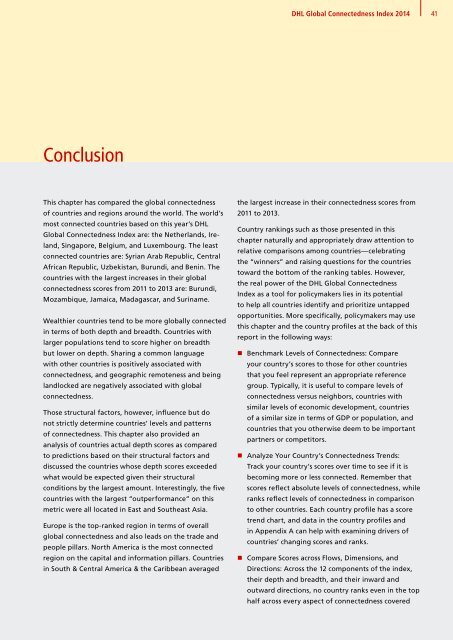DHL Global Connectedness Index 2014
DHL Global Connectedness Index 2014
DHL Global Connectedness Index 2014
- No tags were found...
Create successful ePaper yourself
Turn your PDF publications into a flip-book with our unique Google optimized e-Paper software.
<strong>DHL</strong> <strong>Global</strong> <strong>Connectedness</strong> <strong>Index</strong> <strong>2014</strong><br />
41<br />
Conclusion<br />
This chapter has compared the global connectedness<br />
of countries and regions around the world. The world’s<br />
most connected countries based on this year’s <strong>DHL</strong><br />
<strong>Global</strong> <strong>Connectedness</strong> <strong>Index</strong> are: the Netherlands, Ireland,<br />
Singapore, Belgium, and Luxembourg. The least<br />
connected countries are: Syrian Arab Republic, Central<br />
African Republic, Uzbekistan, Burundi, and Benin. The<br />
countries with the largest increases in their global<br />
connectedness scores from 2011 to 2013 are: Burundi,<br />
Mozambique, Jamaica, Madagascar, and Suriname.<br />
Wealthier countries tend to be more globally connected<br />
in terms of both depth and breadth. Countries with<br />
larger populations tend to score higher on breadth<br />
but lower on depth. Sharing a common language<br />
with other countries is positively associated with<br />
connectedness, and geographic remoteness and being<br />
landlocked are negatively associated with global<br />
connectedness.<br />
Those structural factors, however, influence but do<br />
not strictly determine countries’ levels and patterns<br />
of connectedness. This chapter also provided an<br />
analysis of countries actual depth scores as compared<br />
to predictions based on their structural factors and<br />
discussed the countries whose depth scores exceeded<br />
what would be expected given their structural<br />
conditions by the largest amount. Interestingly, the five<br />
countries with the largest “outperformance” on this<br />
metric were all located in East and Southeast Asia.<br />
Europe is the top-ranked region in terms of overall<br />
global connectedness and also leads on the trade and<br />
people pillars. North America is the most connected<br />
region on the capital and information pillars. Countries<br />
in South & Central America & the Caribbean averaged<br />
the largest increase in their connectedness scores from<br />
2011 to 2013.<br />
Country rankings such as those presented in this<br />
chapter naturally and appropriately draw attention to<br />
relative comparisons among countries—celebrating<br />
the “winners” and raising questions for the countries<br />
toward the bottom of the ranking tables. However,<br />
the real power of the <strong>DHL</strong> <strong>Global</strong> <strong>Connectedness</strong><br />
<strong>Index</strong> as a tool for policymakers lies in its potential<br />
to help all countries identify and prioritize untapped<br />
opportunities. More specifically, policymakers may use<br />
this chapter and the country profiles at the back of this<br />
report in the following ways:<br />
• Benchmark Levels of <strong>Connectedness</strong>: Compare<br />
your country’s scores to those for other countries<br />
that you feel represent an appropriate reference<br />
group. Typically, it is useful to compare levels of<br />
connectedness versus neighbors, countries with<br />
similar levels of economic development, countries<br />
of a similar size in terms of GDP or population, and<br />
countries that you otherwise deem to be important<br />
partners or competitors.<br />
• Analyze Your Country’s <strong>Connectedness</strong> Trends:<br />
Track your country’s scores over time to see if it is<br />
becoming more or less connected. Remember that<br />
scores reflect absolute levels of connectedness, while<br />
ranks reflect levels of connectedness in comparison<br />
to other countries. Each country profile has a score<br />
trend chart, and data in the country profiles and<br />
in Appendix A can help with examining drivers of<br />
countries’ changing scores and ranks.<br />
• Compare Scores across Flows, Dimensions, and<br />
Directions: Across the 12 components of the index,<br />
their depth and breadth, and their inward and<br />
outward directions, no country ranks even in the top<br />
half across every aspect of connectedness covered





